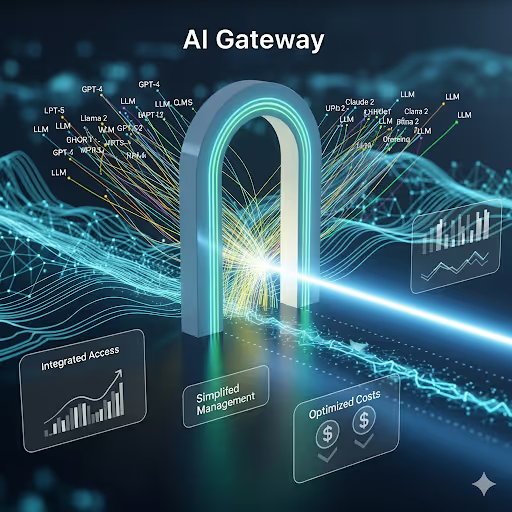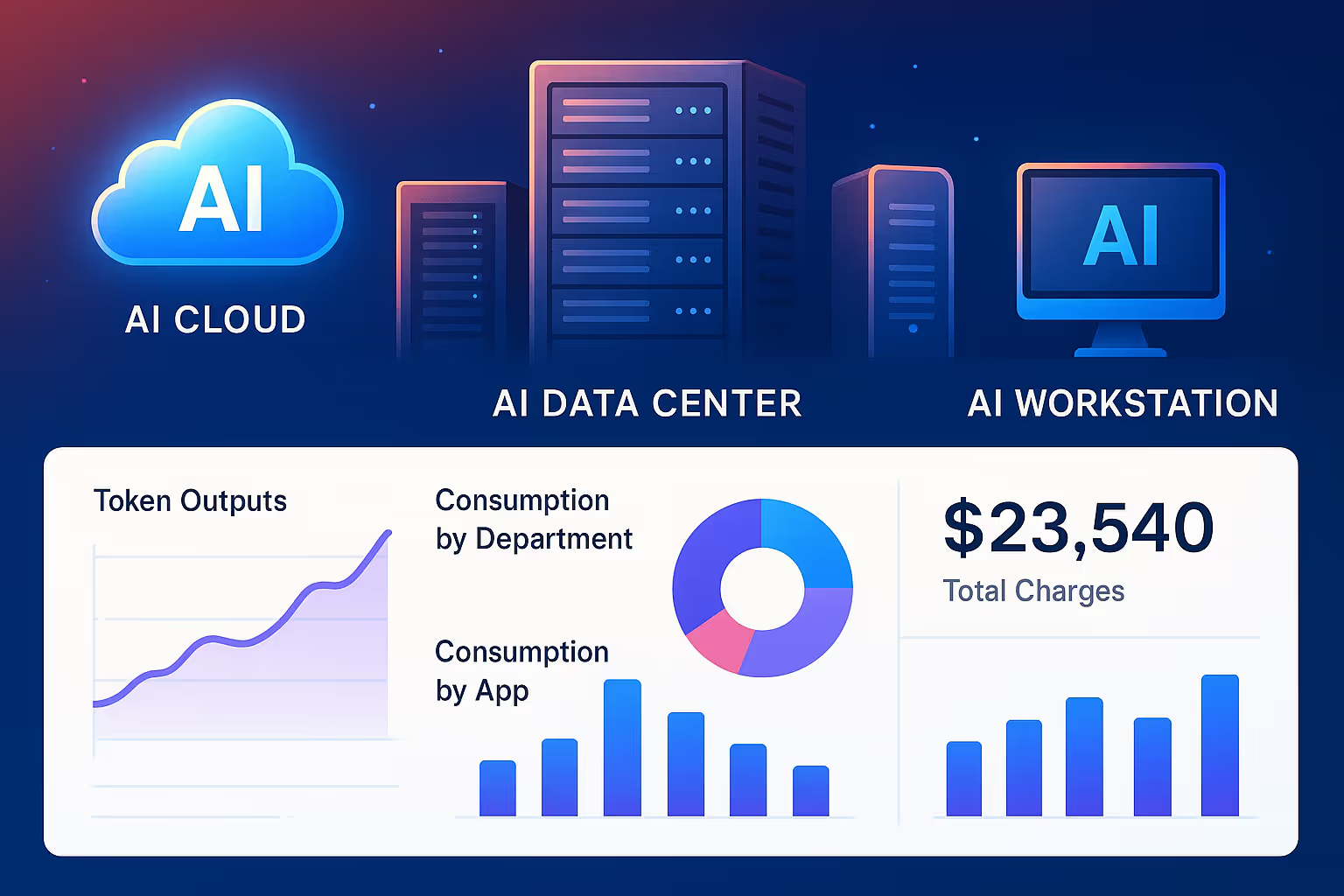As enterprises increasingly integrate generative AI, they face mounting challenges in usage tracking and cost allocation and management. The surge in demand for generative AI applications across multiple projects and business units complicates the ability to track usage and allocate spending effectively. Organizations must prioritize maintaining detailed visibility into usage data and cost distribution to support accurate, transparent pricing models. This insight is crucial for enabling usage-based billing models, implementing chargebacks, and ensuring that generative AI investments align with business impact and strategic needs.
The world of generative AI has seen remarkable growth. LLMs are being deployed across applications and industries and we are only at the beginning stages of the creative ways they are being leveraged. As great as these ideas are, the immense computational resources they consume can translate into equally-great costs for companies that deploy and scale these models. Effectively tracking usage and managing costs is crucial to ensuring that LLMs are sustainable, scalable and don’t ultimately fail.
Let’s explore the primary challenges associated with usage tracking and cost management in generative AI, why these challenges demand a solid technical foundation, and how robust infrastructure helps ensure scalability, continuity, and responsive control.
The Core Challenges of Tracking and Managing Usage and Costs
1. High-Volume Resource Consumption
Usage Tracking
Generative AI models, particularly large-scale ones, require significant computational power. Each request sent to an LLM, even a simple query, triggers substantial backend processes involving large-scale data processing and GPU cycles. This means that costs quickly accumulate, particularly as usage scales. In real-world applications, it's easy for usage to spiral out of control, driving up costs and risking the feasibility of these deployments.
2. Limited Visibility Into Usage Patterns
Cost Optimizations
One of the biggest challenges is understanding the actual usage patterns, broken down by users or applications. When AI services are integrated across various platforms and accessed by diverse user bases, keeping track of who is using what, when, and for how long can be difficult. Without detailed visibility into usage patterns, it's challenging to know where to cut costs effectively or conversely identify high-use areas that might benefit from optimizations.
3. Complexity in Billing Models
Customer Billing
Cloud providers and AI and LLM service vendors have usage-based billing models. For instance, costs may be based on the number of input and output tokens processed, the time taken for response generation, or the model type. Furthermore, these costs fluctuate based on demand, the availability of compute resources, and evolving pricing models from providers, adding another layer of complexity.
Why a Solid Foundation in Usage Metering and Cost Tracking Matters for Usage-Based Models
A strong foundation in usage metering and cost tracking is crucial for businesses moving towards usage-based models. Unlike traditional subscription-based models, usage-based billing requires precise, real-time data collection, processing, and accurate customer billing. Without robust infrastructure tailored to usage metering and cost tracking, companies may struggle with inaccurate billing, service interruptions, and scalability issues that directly impact customer trust and revenue. Here’s a closer look at the infrastructure, security, and scalability needs specific to usage-based business models.
1. Infrastructure Requirements for Usage Metering and Cost Tracking
- Data Collection Pipelines: Reliable, low-latency pipelines that can capture data across various events, endpoints, and user interactions are critical. This requires scalable infrastructure that can ingest high volumes of data in real-time and support data normalization and transformation for consistent, accurate tracking.
- Event Stream Processing: Since usage events often occur in real-time, an infrastructure that supports streaming data (e.g., using tools like Apache Kafka, Kinesis, or similar) is essential. Real-time stream processing enables immediate usage tracking, which is especially valuable for dynamic usage-based billing models.
- Storage Solutions for Long-Term Event History: Usage-based billing requires historical data, both for reference and potential audits. Efficient storage solutions (e.g., using databases optimized for time-series data) are critical for ensuring that event logs and customer usage history are securely stored and quickly retrievable for analysis and billing cycles.
- API Accessibility and Integration: Given that many customers will want insights into their usage or even leverage metered data within their own systems, robust, well-documented APIs are a key part of infrastructure. These APIs allow customers to access real-time usage data and can integrate usage metrics into broader BI or financial systems.
2. Security Requirements for Usage Metering and Billing
- Data Integrity and Tamper-Proofing: Ensuring data integrity is fundamental in usage-based billing, as any changes to the data can directly impact billing accuracy. Cryptographic hashing, data validation protocols, and restricted access controls should be implemented to ensure data remains secure and unaltered.
- Role-Based Access Control (RBAC): Proper RBAC is essential for secure data handling, ensuring that only authorized personnel have access to billing and metering data. This minimizes risks associated with unauthorized access or modifications to sensitive data, especially in environments with multiple departments accessing usage data.
- Compliance with Financial Data Regulations: For companies operating in regions with strict data protection laws (e.g., GDPR, CCPA), ensuring compliance in storing and processing customer usage data is critical. Regular audits, encryption of sensitive data, and secure data handling practices help in meeting these compliance requirements.
- Audit Trails and Transparency: For transparent customer billing, it’s important to provide audit trails that can trace each event back to a source. Logs and audit trails ensure traceability and transparency, allowing both internal teams and customers to verify their usage history and billing calculations.
3. Scalability Needs for Usage-Based Business Models
- Elastic Scaling for High Volume and Peak Demand: Usage spikes can vary by customer behavior or seasonality, so the infrastructure must support elastic scaling. This ensures that peak demands don’t lead to delayed metering or dropped events, which could result in inaccurate billing.
- Data Sharding and Partitioning for Fast Query Performance: As the volume of usage data grows, data sharding and partitioning allow for faster, more efficient querying. Sharding and partitioning help ensure that reports, billing calculations, and customer usage dashboards respond quickly even with large datasets.
- Efficient Cost Management for Infrastructure Scaling: Usage-based models may lead to unpredictable infrastructure costs, so built-in cost tracking for metering infrastructure itself is necessary. This includes tools that offer insights into which parts of the metering infrastructure consume the most resources, allowing proactive cost optimization.
- Automated Scaling and Resource Allocation: Automated provisioning of resources in response to load changes helps prevent overspending on infrastructure while maintaining performance. This is particularly important as metering and billing demands can fluctuate significantly.
4. Specific Requirements for Usage-Based Customer Billing Models
- Accurate Real-Time Metering and Aggregation: In usage-based billing models, every event (e.g., API call, resource consumption, user action) needs to be recorded accurately. Aggregation mechanisms must accurately sum up usage data over time or in specific billing intervals to avoid overcharging or undercharging.
- Dynamic Rate Calculations: Many usage-based billing models offer dynamic pricing or tiered rates, so the billing system must support complex rate calculations that can adjust based on consumption levels, user tier, or real-time adjustments. This is especially true for companies with tiered or volume-discount pricing.
- Customer Usage and Cost Transparency: Providing customers with access to their usage data and costs through a dashboard or regular reports is essential in a usage-based model. This builds trust and allows customers to track their spending, making it easier for them to control their usage.
- Automated Invoicing and Billing Cycles: To minimize manual interventions, the billing system should automate invoicing based on pre-defined billing cycles (e.g., monthly, quarterly) and incorporate any custom rate adjustments or discounts automatically.
- Dispute Resolution and Adjustments: Since customers may question certain billing charges, the infrastructure should support granular tracing of each charge back to individual usage events. This requires a flexible billing backend that can adjust specific charges if needed without disrupting the overall billing cycle.
The Role of Metering with Usage and Cost Analytics
The ability to monitor and analyze usage and cost data in real-time is fundamental. A solid technical foundation often incorporates analytics that provides a granular view of how resources are being used, offering insights into both high-level trends and detailed data points.
Effective usage and cost monitoring tools allow teams to:
- Identify Usage Patterns: Recognize where high costs are occurring and why, helping to strategize optimizations.
- Detect Anomalies: Quickly spot unusual usage spikes that could indicate misuse or inefficiency.
- Optimize for Efficiency: Continuously refine resource allocation to ensure that resources are being used cost-effectively.
Security, Compliance, and Cost Management
Security and compliance also play a crucial role in managing costs. For example, ensuring that LLM deployments comply with data regulations can help avoid costly fines and legal expenses. Moreover, secure access control prevents unauthorized users from generating additional costs.
A strong technical foundation supports:
- Data Access Controls: Restricting access to models and resources based on user roles to prevent unnecessary or unauthorized usage.
- Compliance Monitoring: Tracking usage to ensure it aligns with data privacy laws, which can mitigate the risk of compliance-related fines.
- Audit Trails: Keeping logs of all actions taken within the system, which provides transparency and accountability.
Building a Foundation for Growth, Cost Efficiency, and Resilience
For companies leveraging generative AI, having a technical foundation that can scale while managing costs is a strategic advantage. This foundation supports growth, ensures non-interrupted service, and enables quick, decisive action when needed. It reduces the chances of cost overruns or resource shortages and allows companies to pivot quickly when usage patterns shift.
In summary, a solid technical foundation helps organizations:
- Scale effectively without unexpected cost spikes or downtimes.
- Maintain service reliability and ensure customer satisfaction.
- Rapidly control usage and expenses as needed, with real-time visibility and responsive measures.
- Navigate billing complexities and enforce compliance to prevent unnecessary costs.
A robust technical foundation for generative AI models isn't just about supporting current operations—it's an investment in long-term sustainability, agility, and resilience. In the fast-paced world of AI, this foundation is critical to staying competitive and keeping operational costs under control.
This is exactly what we set out to solve here at Amberflo and we are uniquely positioned to offer you the most reliable and scalable platform for usage tracking, cost allocation, and billing management. If you'd like to learn more, feel free to book a demo with us. We'd love to walk you through it with no obligation.





.svg)

